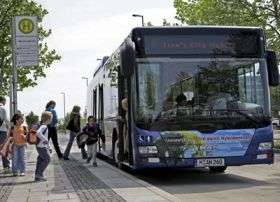Hybrid Bus in the City: A Prototype with a Future

Nuremberg’s public transport system has become more "electrified" thanks to a diesel-electric hybrid bus developed by MAN. The vehicle is equipped with drive-system technology from Siemens.
The prototype, which also features a special brake energy recovery system, uses up to 25 percent less fuel than conventional buses. The drive system consists of series-produced components, which means mass production of the bus is a possibility that MAN is planning to turn into reality by 2010.
In addition to a combustion engine, hybrid vehicles have an electric motor that initially puts the vehicle in motion. This system has a particularly positive effect on fuel consumption in urban driving situations and during rush hour. The electric motor also serves as a generator: When the vehicle brakes, the kinetic energy is not lost, but is instead converted into electricity and stored. This energy is later used to power the vehicle. Hybrid drives are ideal for city buses, which brake and accelerate frequently (e.g. at bus stops and traffic lights).
Working together with specialists from MAN, Siemens Automation and Drives (A&D) connected a diesel engine to an electric power pack consisting of generators, frequency converters, drive motors, and transmission components. The system is now being tested in the Lion’s City Hybrid prototype bus, which operates in Nuremberg.
Depending on engine rpm, energy management software from A&D regulates the energy flow from the electric or diesel drive, and then transfers this energy to the bus drive shaft via the transmission. Special high-performance capacitors store the energy and then supply enough of it to put the vehicle in motion. The prototype has been operating successfully, and MAN is confident that it can begin mass producing the hybrid bus in Europe by 2010 at the latest.
In the meantime, the third test hybrid bus from A&D and MAN has now hit the road in Nuremberg. The Nuremberg buses aren’t the only ones with technology from Siemens, however, as there are currently 1,000 hybrid buses on the road equipped with A&D systems that are being tested in some 30 different projects.
Source: Siemens





















